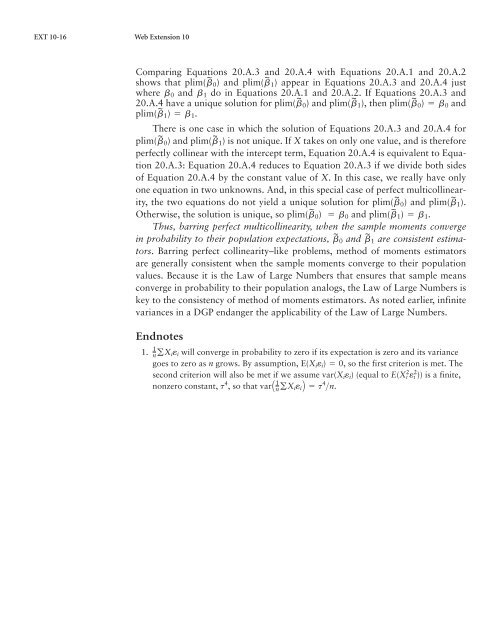Chapter 20 Generalized Method of Moments Estimators and ...
Chapter 20 Generalized Method of Moments Estimators and ...
Chapter 20 Generalized Method of Moments Estimators and ...
You also want an ePaper? Increase the reach of your titles
YUMPU automatically turns print PDFs into web optimized ePapers that Google loves.
EXT 10-16 Web Extension 10<br />
Comparing Equations <strong>20</strong>.A.3 <strong>and</strong> <strong>20</strong>.A.4 with Equations <strong>20</strong>.A.1 <strong>and</strong> <strong>20</strong>.A.2<br />
shows that plim(b ~ 0) <strong>and</strong> plim(b ~ 1) appear in Equations <strong>20</strong>.A.3 <strong>and</strong> <strong>20</strong>.A.4 just<br />
where b 0 <strong>and</strong> b 1 do in Equations <strong>20</strong>.A.1 <strong>and</strong> <strong>20</strong>.A.2. If Equations <strong>20</strong>.A.3 <strong>and</strong><br />
<strong>20</strong>.A.4 have a unique solution for plim <strong>and</strong> plim , then plim <strong>and</strong><br />
plim (b ~ (b ~ 0) (b ~ 1) (b ~ 0) = b 0<br />
1) = b 1 .<br />
There is one case in which the solution <strong>of</strong> Equations <strong>20</strong>.A.3 <strong>and</strong> <strong>20</strong>.A.4 for<br />
plim(b ~ 0) <strong>and</strong> plim(b ~ 1) is not unique. If X takes on only one value, <strong>and</strong> is therefore<br />
perfectly collinear with the intercept term, Equation <strong>20</strong>.A.4 is equivalent to Equation<br />
<strong>20</strong>.A.3: Equation <strong>20</strong>.A.4 reduces to Equation <strong>20</strong>.A.3 if we divide both sides<br />
<strong>of</strong> Equation <strong>20</strong>.A.4 by the constant value <strong>of</strong> X. In this case, we really have only<br />
one equation in two unknowns. And, in this special case <strong>of</strong> perfect multicollinearity,<br />
the two equations do not yield a unique solution for plim <strong>and</strong> plim .<br />
Otherwise, the solution is unique, so plim(b ~ (b ~<br />
<strong>and</strong> plim (b ~ 0) (b ~ 1)<br />
0) = b 0 1) = b 1 .<br />
Thus, barring perfect multicollinearity, when the sample moments converge<br />
in probability to their population expectations, b ~ <strong>and</strong> b ~ 0 1 are consistent estimators.<br />
Barring perfect collinearity–like problems, method <strong>of</strong> moments estimators<br />
are generally consistent when the sample moments converge to their population<br />
values. Because it is the Law <strong>of</strong> Large Numbers that ensures that sample means<br />
converge in probability to their population analogs, the Law <strong>of</strong> Large Numbers is<br />
key to the consistency <strong>of</strong> method <strong>of</strong> moments estimators. As noted earlier, infinite<br />
variances in a DGP endanger the applicability <strong>of</strong> the Law <strong>of</strong> Large Numbers.<br />
Endnotes<br />
1<br />
1. n gX ie i will converge in probability to zero if its expectation is zero <strong>and</strong> its variance<br />
goes to zero as n grows. By assumption, E(X i e i ) = 0, so the first criterion is met. The<br />
second criterion will also be met if we assume var(X (equal to E(X 2 is a finite,<br />
nonzero constant, t 4 , so that varA 1 i e 2 i e i )<br />
i ))<br />
n gX ie iB = t 4 >n.
















